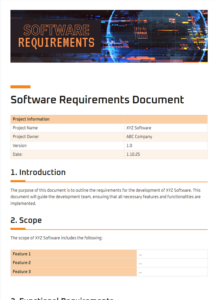Writing requirements templates can be a challenging task, especially when you’re trying to create a document that will be used by multiple stakeholders. A well-written requirements template can help you to gather and document the requirements of your project in a clear and concise way. This will help to ensure that everyone is on the same page and that the project is completed successfully.
There are many different types of requirements templates available, and the best one for you will depend on the specific needs of your project. However, all requirements templates should include the following information:
What is a Business Requirements Document?
A Business Requirements Document (BRD) is a foundational document that outlines the business needs and objectives for a software development project. It serves as a bridge between the business and technical teams, ensuring that the software aligns with the organization’s strategic goals. In the SDLC (Software Development Life Cycle), the BRD is typically created during the requirements gathering and analysis phase.
The BRD provides a detailed description of the business problem that the software aims to solve. It outlines the pain points, challenges, and opportunities that have been identified. The BRD also defines the scope of the project, specifying the features and functionalities that the software will deliver. Furthermore, it establishes acceptance criteria, which define the metrics for measuring the success of the software.
Key Elements of a BRD
An effective BRD should include the following key elements:
1. Executive Summary: Provides a concise overview of the BRD, including the project’s purpose, goals, and scope.
2. Business Objectives: Clearly states the business goals and objectives that the software is intended to achieve.
3. Stakeholder Analysis: Identifies the stakeholders involved in the project and their roles, interests, and expectations.
4. Requirements: Lists the functional and non-functional requirements of the software, including detailed descriptions, use cases, and acceptance criteria.
5. Glossary: Defines technical terms and acronyms used in the document to ensure clarity and consistency.
Conclusion
A comprehensive and well-structured BRD is crucial for successful software development projects. It serves as the foundation for project planning, design, and implementation. By clearly defining the business needs and requirements, the BRD reduces the risk of miscommunication, delays, and costly rework.
To create an effective BRD, it is recommended to engage stakeholders from both the business and technical sides. Collaborative workshops and interviews can assist in gathering the necessary information and perspectives. Additionally, utilizing templates and tools specifically designed for SDLC business requirements can streamline the process and ensure a consistent and professional document.

